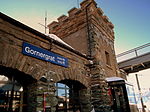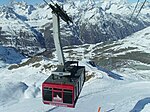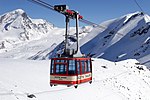KOSMA

The Kölner Observatorium für SubMillimeter Astronomie (KOSMA) was a radio telescope for submillimeter astronomy located at 3,135 m (10,285 ft) on Gornergrat near Zermatt (Switzerland). It was operated by I. Physikalisches Institut, University of Cologne, and Radioastronomisches Institut, University of Bonn.The telescope had a primary diameter of 3 m (9.8 ft), and a secondary diameter of 0.27 metres (0.89 ft). It was equipped with heterodyne receivers covering 210 to 820 GHz, corresponding to wavelengths between 0.35 and 1.4 mm, for observations of lines from the interstellar medium.Because of the good climatic conditions at the altitude of 3135 m (10285 ft), astronomical observatories have been located in both towers of the Kulmhotel at Gornergrat since 1967. In 1985, the KOSMA telescope was installed in the southern tower by the Universität zu Köln and, in the course of 1995, replaced by a new dish and mount. In the northern tower, a 1.5 m infrared telescope was operated until 2005 by an Italian association of universities (TIRGO). In 2010, the telescope was moved to a site in Yangbajain in Damxung County in Tibet at an altitude of 4300m and renamed CCOSMA.
Excerpt from the Wikipedia article KOSMA (License: CC BY-SA 3.0, Authors, Images).KOSMA
Gornergrat - Hohtälli,
Geographical coordinates (GPS) Address Nearby Places Show on map
Geographical coordinates (GPS)
| Latitude | Longitude |
|---|---|
| N 45.9844 ° | E 7.7858 ° |
Address
Gornergrat - Hohtälli
3920
Wallis, Switzerland
Open on Google Maps










